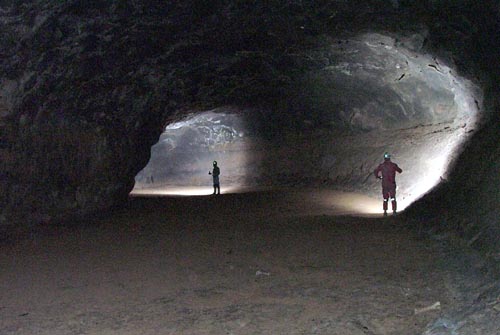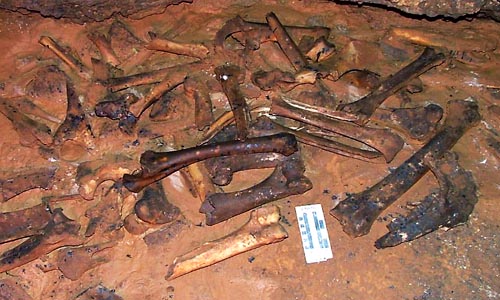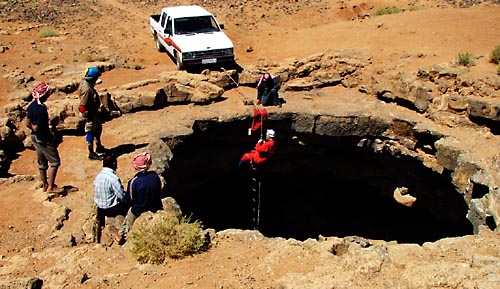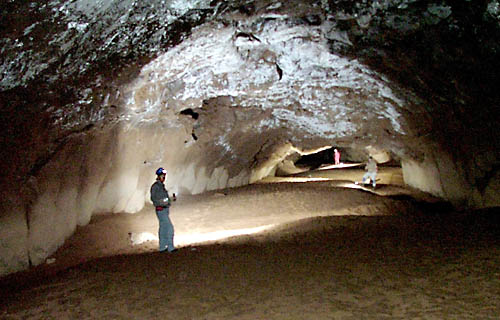Click on the picture to see the complete map.

Lava Caves of Jordan
Stephan Kempe[1], Ahmad Al-Malabeh[2], Horst-Volker Henschel[3]
©2005 by the authors
The central section of Jordan is covered by young alkali olivine basaltic lava flows, the Harrat Al-Jabban volcanics, part of the large intercontinental Harrat As Scham volcanic field. The origin of these lavas may be connected to the existence of a continental intraplate hot spot plume. Its eruptive site should appear to move southward as the Arabian Plate moves northward due to the opening of the Red Sea. The top most and therefore youngest flows, are ca. 400 000 years old (Tarawneh et al., 2000). In these lavas we explored, surveyed and studied in September 2003 two lava tunnels (Abu Al-Kursi and Beer Al-Hamam) and two other lava caves (Table 1).
Table 1: Data of Jordan lava caves (locations WGS 84).
|
Name of Cave |
Latitude |
Longitude |
Stations |
Length |
Stations |
Depth |
Direction |
Type |
|
Abu Al-Kursi W |
32°* |
36°* |
2 to 18 |
77.1 m |
2 to 18 |
8.1m |
N-S |
Lava Tunnel |
|
Abu Al-Kursi E |
32°* |
36°* |
20 to 34 |
153.7m |
1 to 34 |
12.2 m |
W-E |
Lava Tunnel |
|
Azzam Cave |
32°* |
36°* |
13 to 25 |
44.1 m |
1 to 25 |
4.2 m |
NWN-SES |
Pressure Ridge |
|
Beer Al-Hamam |
32°* |
36°* |
32 to 23 |
445 m |
1 to 23 |
17.2 m |
NW-SE |
Lava Tunnel |
|
Dahdal Cave |
32°* |
36°* |
5 to 12 |
28.9 m |
1 t0 12 |
0.0 m |
SW-NE |
Pressure Ridge |
*NB: For the sake of cave conservation and protection, minutes of longitude and latitude have been removed from this table - J. Pint, editor
The two smaller caves are most probably pressure ridge caves formed by the buckling-up of the upper layers of the still hot and plastic pahoehoe flows flowing down from near-by Al-Qu’ays Volcano. Abu Al-Kursi (Figs. 1, 2, 3) and Beer Al-Hamam (Fig. 4, 5) on the other hand are large lava tunnels, up to 15 m wide and 8 m high, which served to transport lava subterraneously over large distances, i.e. possibly over several tens of kilometres. They are now accessible through ceiling collapses, which allow studying the structure of the roofs. These consist of uninterrupted sets of lava sheets which show that the tunnels did not form by over-crusting lava channels but by repeated under-flowing and inflating of initial lava deltas. In this way the lava flows build forward only at the tip, while the rest of the flow is stationary apart from the lava flowing in the tunnel inside. These processes have been studied in Hawaii (e.g., Kempe, 2002) and can now be used to interpret the findings in Jordan. The discovery of these tunnels shows that the basaltic lava must have been very hot upon eruption, and that they were piped through the tunnels over large distances, thus allowing flow over terrain at slopes of around or less than 2°, comparable to the distal slopes of Hawaiian volcanoes. In fact there should have been many of these tunnels in parallel in these youngest flows.
Due to the great age of the flows, it came somewhat as a surprise that the tunnels are still accessible. Dahdal Cave, Abu Al-Kursi and Beer Al-Hamam contain thick deposits of sediments, which -in case of two latter caves- are also the cause of their terminations. Beer Al-Hamam is entered by a wadi during torrential rains, which washes sediment from the surface into the tunnel. The lower part of the cave ponds during rains and it fills with a large reservoir of water. In the upper part of the cave the sediment surface shows signs of fast flowing water. The sediments have been sampled at a profile. They are mostly silts with some fine sand and they contain large concentrations of ammonium nitrate in the upper centimetres, derived from pigeon droppings. In both sections of Abu Al-Kursi, the sediment floor is smooth, covered with a thin layer of fines, laid down by occasional floods that pond at the end of the caves. No sign of flowing water is seen.
All caves are known locally. Azzam Cave has been used as a sheep pen until recently. Its entrance seems to be dug out as suggested by a sediment pile nearby containing pot shards. Abu Al-Kursi is visited by adventurous explorers from time to time as is evident from black droppings caused by the use of plastic irrigation pipes as makeshift torches. Beer Al-Hamam must have been visited in the past because we found stone cairns inside but its visit involves climbing down into a 5 m deep overhanging pit. Dahdal Cave was also visited in the past, since it contains a stone wall. These visits may date to prehistoric times though. Plenty of flint stone tools (neolithic?) are found in the surrounding of Dahdal Cave and in two digs in the entrance of Abu Al-Kursi. Dahdal Cave and both sections of Abu-Al-Kursi contain camel bones and may have been used by hyenas as dens in the past (Fig. 3). Shallow circular pits are found throughout Abu Al-Kursi, they do not seem to be anthropogenic since the dug-out material is missing. Possibly these are hyena or wolf sleeping pits. A wolf or jackal mandible was collected in the cave.
References
Kempe, S. (2002): Lavaröhren (Pyroducts) auf Hawai‘i und ihre Genese. - In: W. Rosendahl & A. Hoppe (Hg.): Angewandte Geowissenschaften in Darmstadt; Schriftenreihe der deutschen Geologischen Gesellschaft, 15: 109-127.
Tarawneh, K., Ilani, S, Rabba, I., Harlavan, Y., Peltz, S., Ibrahim, K., Weinberger, R. & Steinitz, G. (2000): Dating of the Harrat Ash Shaam Basalts Northeast Jordan (Phase 1). – Nat. Res. Authority; GSI
|
Fig. 1: Survey of the lava tunnel Abu Al-Kursi in Jordan:
detail. Click on the picture to see the complete map.
|
 |
|
Fig. 2:
View of Eastern Hall of
Abu Al-Kursi,
located in the
Harrat Al-Jabban volcanics.
|
 |
|
Fig. 3:Bones found inside
of Abu Al-Kursi,
possibly carried into the cave by hyenas.
|
 |
|
Fig. 4:
Entrance to Beer Al-Hamam, a circa
6 m deep collapse hole
in roof of lava tunnel.
|
 |
|
Fig. 5: Inside
Beer Al-Hamam.
Note sediment-covered floor.
|
 |
[1] Prof. Dr. S. Kempe, University of Technology, Institute of Applied Geosciences, Schnittspahnstr. 9, D-64287 Darmstadt, Germany; email kempe@geo.tu-darmstadt.de
[2] Prof. Dr. A. Al-Malabeh, Hashemite University, Department of Earth and Environmental Sciences, P.O. Box 150459, Zarka 13115, Jordan;
[3] Dr. H.-V. Henschel, POB 110661; D-64221 Darmstadt; Germany.